Sean Dyche openly admitted that he has “massive work to do” at the club following Everton’s defeat to Arsenal.
Despite some offensive improvements compared to Frank Lampard’s tenure, Everton‘s start to the season 2023/24 under Sean Dyche has been disappointing, marked by a lack of victories and the lowest goal tally in the English Premier League.
This downturn in form comes at a critical juncture for the club, as they recently underwent a change in ownership, now under the stewardship of American owners, 777 Partners.
This transition raises a pertinent question: Is Sean Dyche’s somewhat old-fashioned tactical approach—long balls, maintaining width, direct play, long vertical balls, and compact defensive blocks, still suitable for Everton’s future?
The current campaign has exposed defensive vulnerabilities within the Toffees, leading to a winless streak, with just one draw and multiple defeats.
This poor performance has placed them near the bottom of the league table, conceding nine goals at the time of this analysis.
In terms of Sean Dyche tactics, he typically deploys Everton in either a 4-1-4-1 defensive shape (more than 60% of the time) or a 4-4-1-1 structure (11%), featuring a solitary defensive midfielder positioned between the lines.

Deep penetration
Sean Dyche’s defensive approach predominantly centres around deploying a 4-1-4-1 structure with a mid or low block.
His procedure aims to limit the spaces between the lines, preventing opponents from effectively playing vertically on the ground.
Moreover, Dyche aims to compel them into physical battles, engaging in duels on the flanks, launching long balls, or delivering crosses—areas where his team typically excels.
A notable concern arose in the early games of the season when there was a consistent shift from 4-1-4-1 to 4-4-2.
In this transition, one of the No. 8 midfielders would push higher up alongside the striker in the first line of defensive block.
This tactical shift requires the defensive midfielder, usually Idrissa Gueye or, more recently, André Onana against Arsenal, to display exceptional movement, positional awareness, space recognition and intelligence in decisions when to move.
No. 6 takes on the responsibility of filling the void left by the advancing No. 8.
This situation often gives rise to issues related to positioning, decision-making, and timing for pressing and movement.
When the No. 6 midfielder steps forward, a significant gap emerges between the somewhat advanced midfield and the backline.
While the defensive line attempts to push up to close this gap, opponents can still exploit the space between the lines and penetrate Everton’s block.
During Everton’s 4-0 defeat to Aston Villa.
Everton’s right central midfielder Abdoulaye Doucouré moved up to the first line alongside Dominic Calvert-Lewin to avoid a 3v1 situation and create 4-4-2 against Aston Villa’s 3-2-5 in-possession structure.
Consequently, Idrissa Gueye shifted from the central position to the right to cover the vacant space.

Both players in the first line were tasked with shadowing and blocking the central passing lanes.
Although Calvert-Lewin was somewhat lax in staying close to Kamara, Pau Torres found Kamara, who then passed to Douglas Luiz.
This forced Idrissa Gueye to advance and counter Douglas Luiz.

The ball bounced between them, with Douglas Luiz eventually running in behind and passed to the advanced Moussa Diaby, who occupied the right half-space.
Meanwhile, Everton’s centre-backs were preoccupied with the striker, and the left-back faced confusion while dealing with Diaby and Aston Villa’s right winger, leaving no one to engage Moussa Diaby.

As a result, Diaby progressed and passed to Leon Bailey.
He was positioning himself strategically to receive a cutback pass as Idrissa Gueye rushed intensely into the box.


Finally, Bailey crossed the ball to John McGinn, who executed a well-timed curved run into the box and scored the goal.

In the context of Everton’s 1-0 loss to Fulham, there were notable defensive lapses involving the holding midfielder and others.
The ball reached Fulham’s right-back Kenny Tete on the side.
Everton’s winger pressed while the striker applied pressure to prevent a pass back to Fulham’s centre-back.
At this juncture, Amadou Onana’s responsibility was to either close down passing lanes or keep a watchful eye on Lukovic’s area, anticipating a potential pass to him.

However, Idrissa Gueye made an ill-advised decision.
Instead of defending the space and obstructing any passes towards Aleksandar Mitrović, he pushed slightly higher, inadvertently opening up a passing lane to Mitrović.
The right winger, Harry Wilson, astutely recognised this vulnerability and swiftly exploited the space, with Mitrović positioned far enough from Idrissa.
The nearest defender was tasked with maintaining depth while another pulled the Fulham player slightly to the side.

Andreas Pereira found himself unmarked in the left half-space in the absence of Abdoulaye Doucouré or even James Garner.
As Aleksandar Mitrović received the ball quickly, Michael Keane engaged him, prompting Andreas Pereira to exploit the gap in Everton’s defensive line, compelling the right full-back Nathan Patterson to track him and vacate his wing.

Andreas Pereira promptly delivered a precise cross to the unmarked winger Bobby Decordova-Reid on the opposite flank, resulting in the decisive goal of the match.

Swift switches
One of the most effective strategies for breaking down deep and compact defences involves inducing rapid shifts from one side to the other through swift switches.
Everton’s persistent individual and collective errors have been a recurring issue.
In their match against Sheffield United, when the ball was played out to the left side to Yasser Larouci, Everton’s nearest No.
8 Abdoulaye Doucouré, as usual, dropped back to fill the gap into the half-space left by the right fullback, who had moved forward to engage the opposition.
Larouci promptly returned the ball to the player positioned for the switch.

Subsequently, the ball was swiftly moved to the centre of the pitch, where Vinícius Souza was stationed.
Idrissa Gueye opted to close down Souza quickly, which created space in depth.
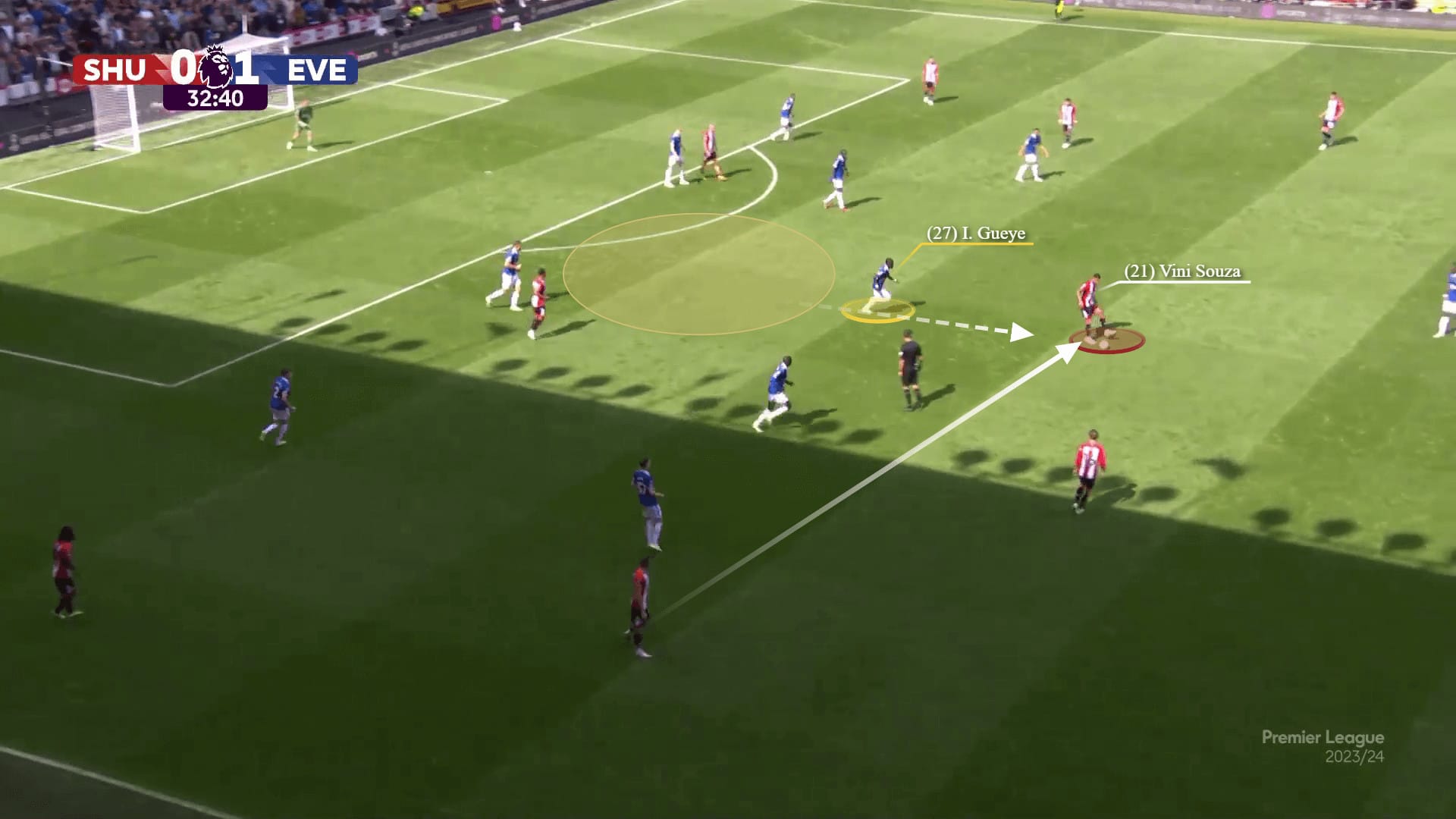
Surprisingly, Gueye failed to recover his position, and neither did Abdoulaye Doucouré nor any other teammate.
This left a void in the defensive setup, which Cameron Archer exploited by positioning himself in that space.

Following the successful switch, a cross was delivered without any significant pressure, allowing Oliver McBurnie to control it comfortably and lay it off into space for Cameron Archer, who capitalised on this collective error to score a goal.

Crosses also have proven to be an effective method for breaking through Everton’s defence, provided they are executed skillfully.
In many cases, the pressure on the player delivering the cross is insufficient to hinder their accuracy, and the defensive response, even from Everton’s defenders, sometimes falls short.
This concept was prominently illustrated in their match against Wolves, a game they narrowly lost by a single goal.
Pedro Neto faced minimal noise, even though he found himself in a 2-on-1 situation as he prepared to deliver the cross.
He managed to find striker Saša Kalajdžić in a 3v3 situation.
Kalajdžić cleverly manipulated James Tarkowski, exploiting his blind spot, and ultimately secured the decisive goal for his team.

Breaking through Everton’s defensive structure using switches can take various forms, whether it’s a low, methodical approach that involves shifting players and exploiting gaps or a high-speed manoeuvre to condense the opposition and secure a numerical advantage.
In this instance, Sheffield players manipulated Everton’s defensive block and switched to the opposite side, creating a favourable 3v2 situation.

George Baldock and Gustavo Hamer brilliantly executed a quick 1-2 combination against the lone fullback, then Baldock returned the cutback to Hamer, who shot it in light of the lack of an immediate return from the midfield or proactiveness from the defenders, but Pickford was brilliant in blocking it.
George Baldock and Gustavo Hamer executed a brilliantly timed 1-2 combination against the lone fullback.
Subsequently, Baldock delivered a precise cutback to Hamer, who attempted a shot due to the absence of a quick response from the midfield and the defenders’ lack of proactive positioning.
However, Jordan Pickford exhibited exceptional goalkeeping skills, denying the scoring opportunity.

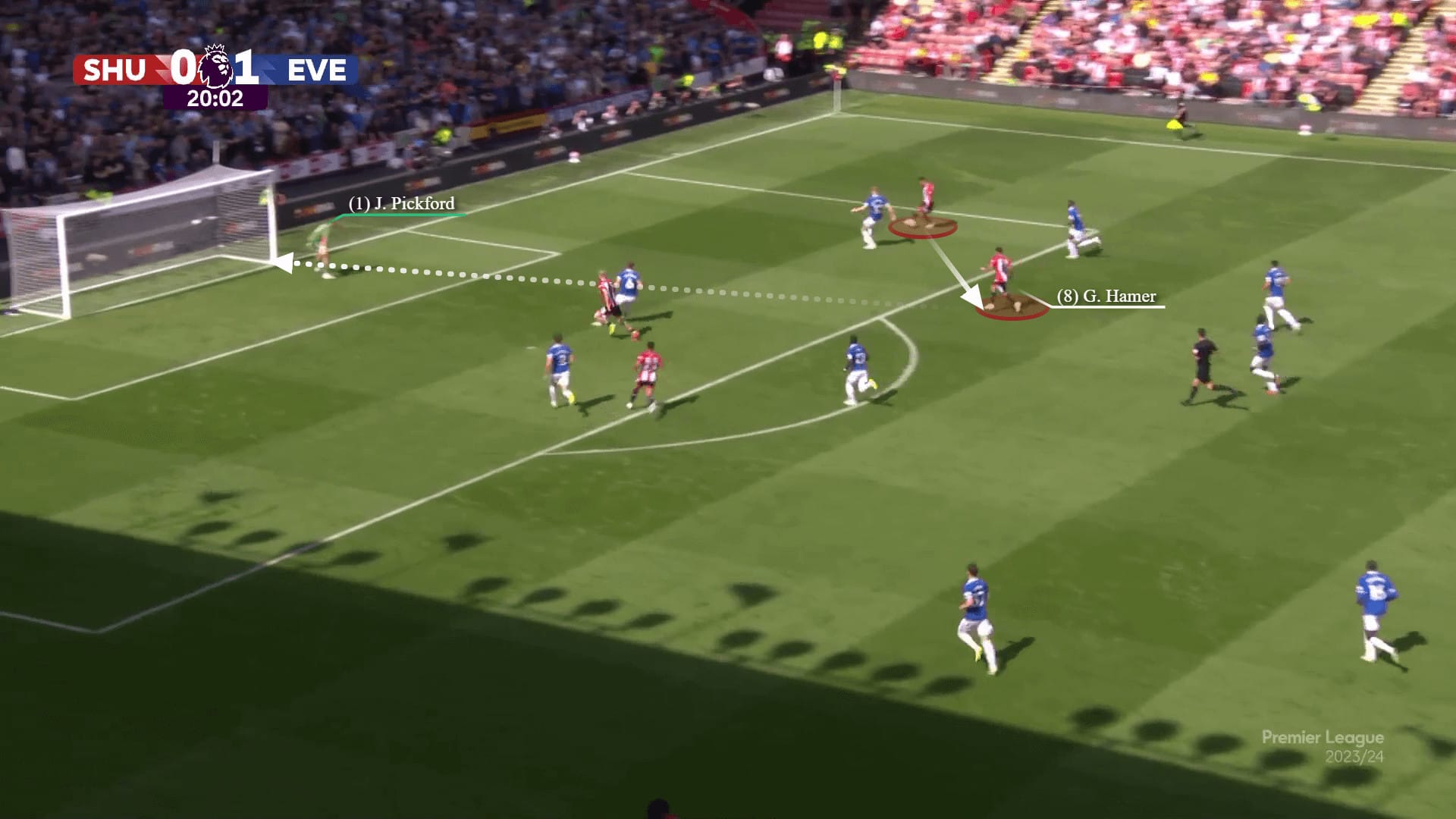
When facing top-tier teams, the quick and sharp switch from one half-space to another and then penetrating quickly at an appropriate moment becomes clear.
A pivotal moment occurred in a match against Arsenal when the attack stuck on the right side.
The ball was eventually backed to William Saliba, who made a pass to the inverted fullback Oleksandr Zinchenko in the left half-space.
This short switch by Arsenal compelled Everton’s defensive line to move higher up the pitch, leaving spaces open behind them.
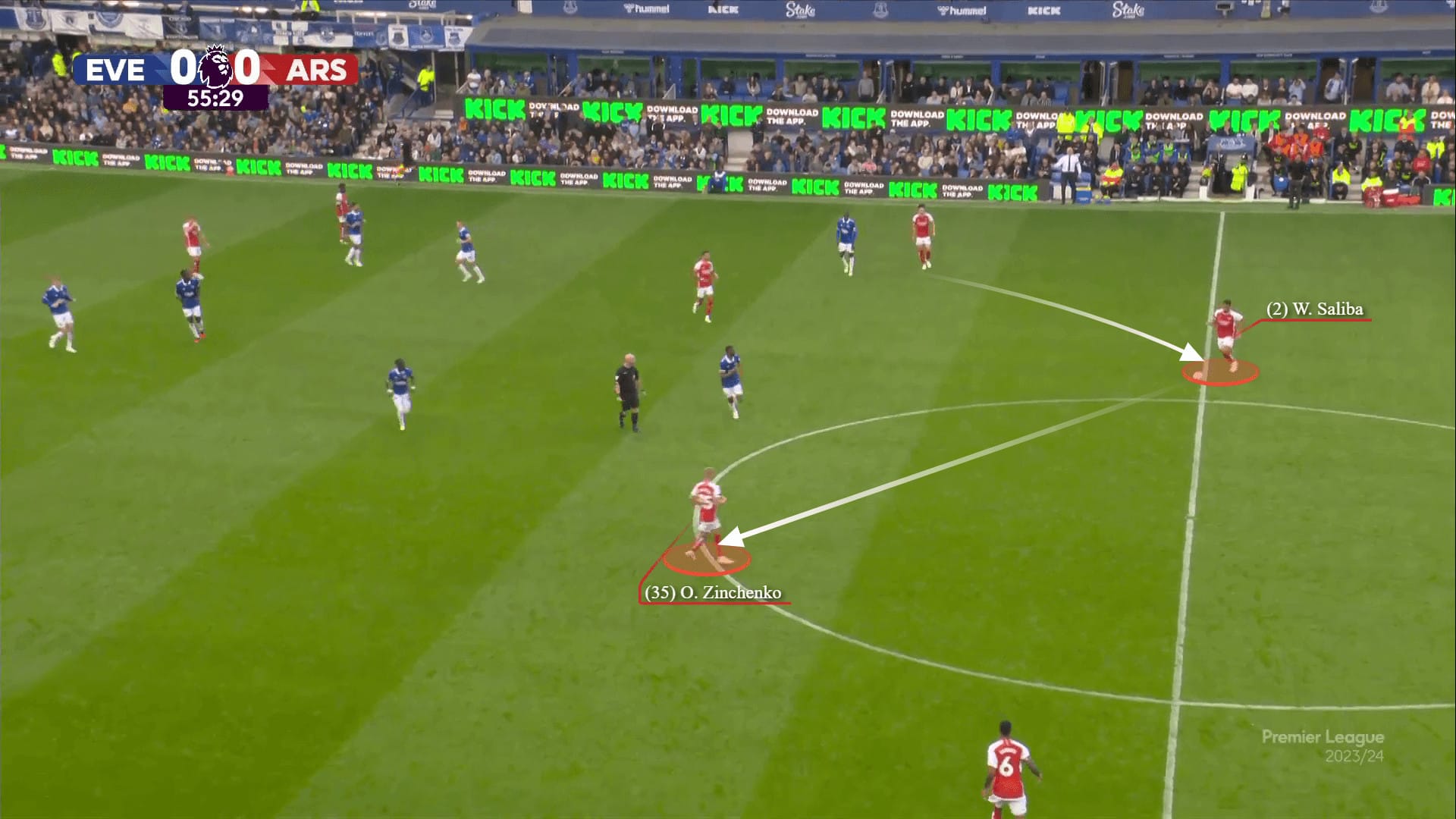
At a critical moment, Zinchenko executed a superb long pass, playing it behind the defence to the inside forward Leandro Trossard.

Trossard delivered a driven cross from inside the penalty area, only to have it blocked by a defender.
Subsequently, another defender blocked the follow-up attempt, thwarting Arsenal’s scoring opportunity despite their proximity to the goal.

High pressing
In their pressing phases, Dyche employs a 4-4-2 pressing scheme using the No.
6 centre-back type, where one of the two players in the first line presses the ball-carrying centre-back while the other marks the nearest No. 6.
Until this writing, Everton has displayed a commendable record in pressing, with 54 high regains.
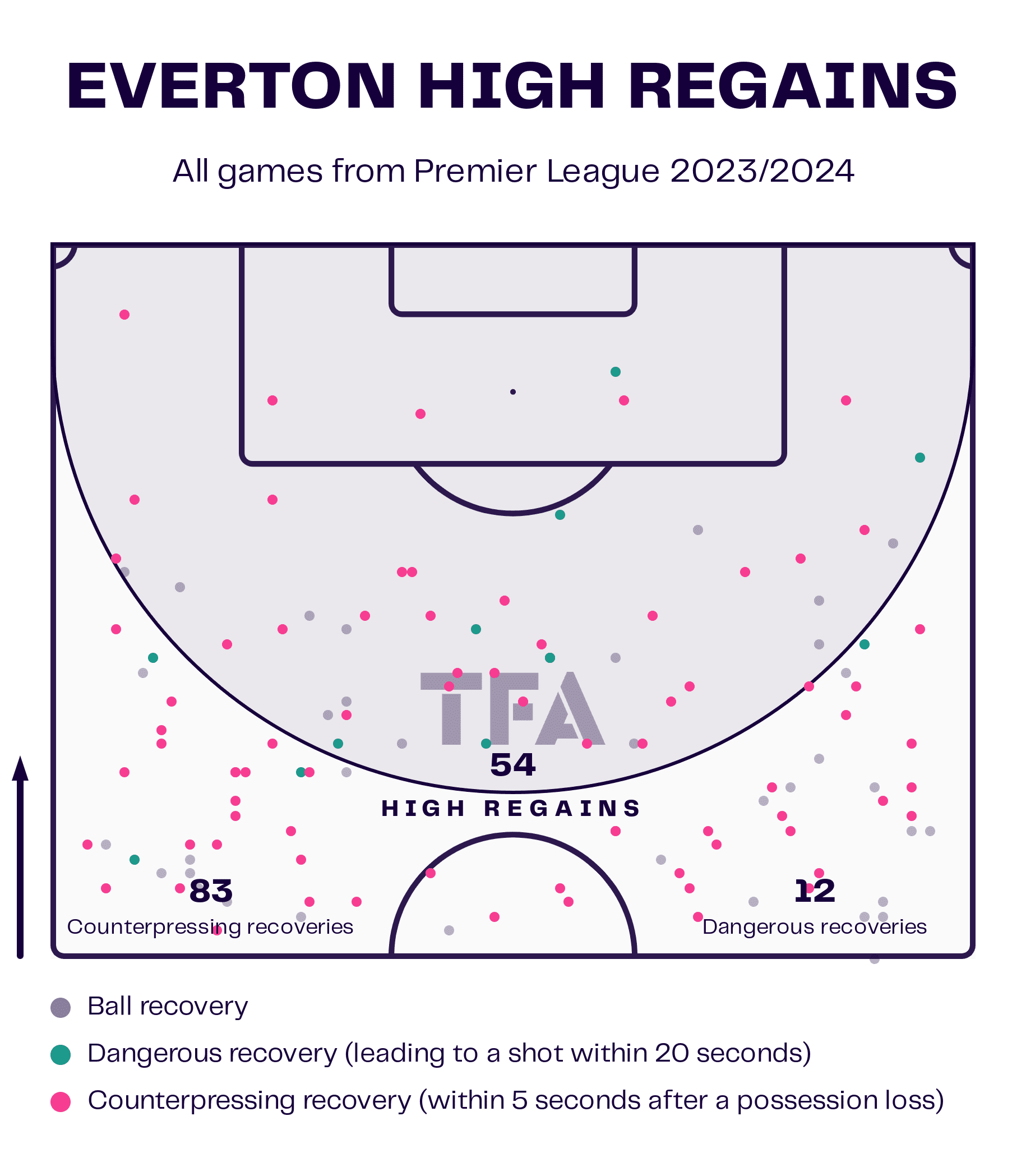
However, a potential issue with this pressing system emerges when it’s bypassed by a precise laser or long pass behind the defensive line where the players do not have the speeds or prediction to defend against such situations.
This can lead to significant problems and create scoring opportunities for the opposition.
Here below against Wolves, when Max Kilman received the ball from the goalkeeper, Abdoulaye Doucouré stepped up to apply pressure, and Arnaut Danjuma dropped back to mark the nearest No. 6 to the ball.
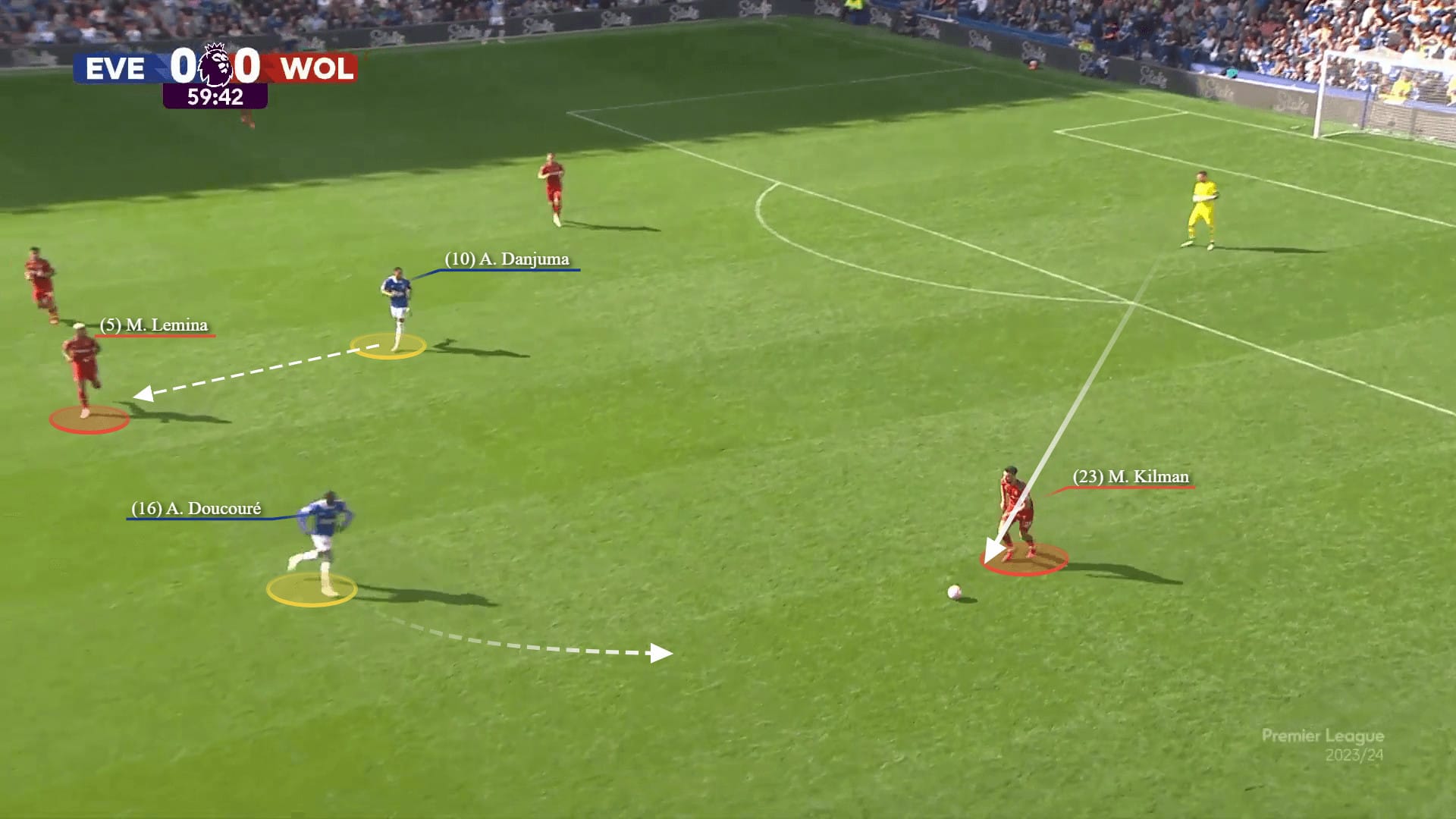
Max Kilman executed a slight laser pass behind Everton’s defence.
Unfortunately, there was a breakdown in communication between Jordan Pickford and James Tarkowski.
Fabio capitalised on this, quickly reaching the ball and coming close to scoring, although he ultimately missed the chance.
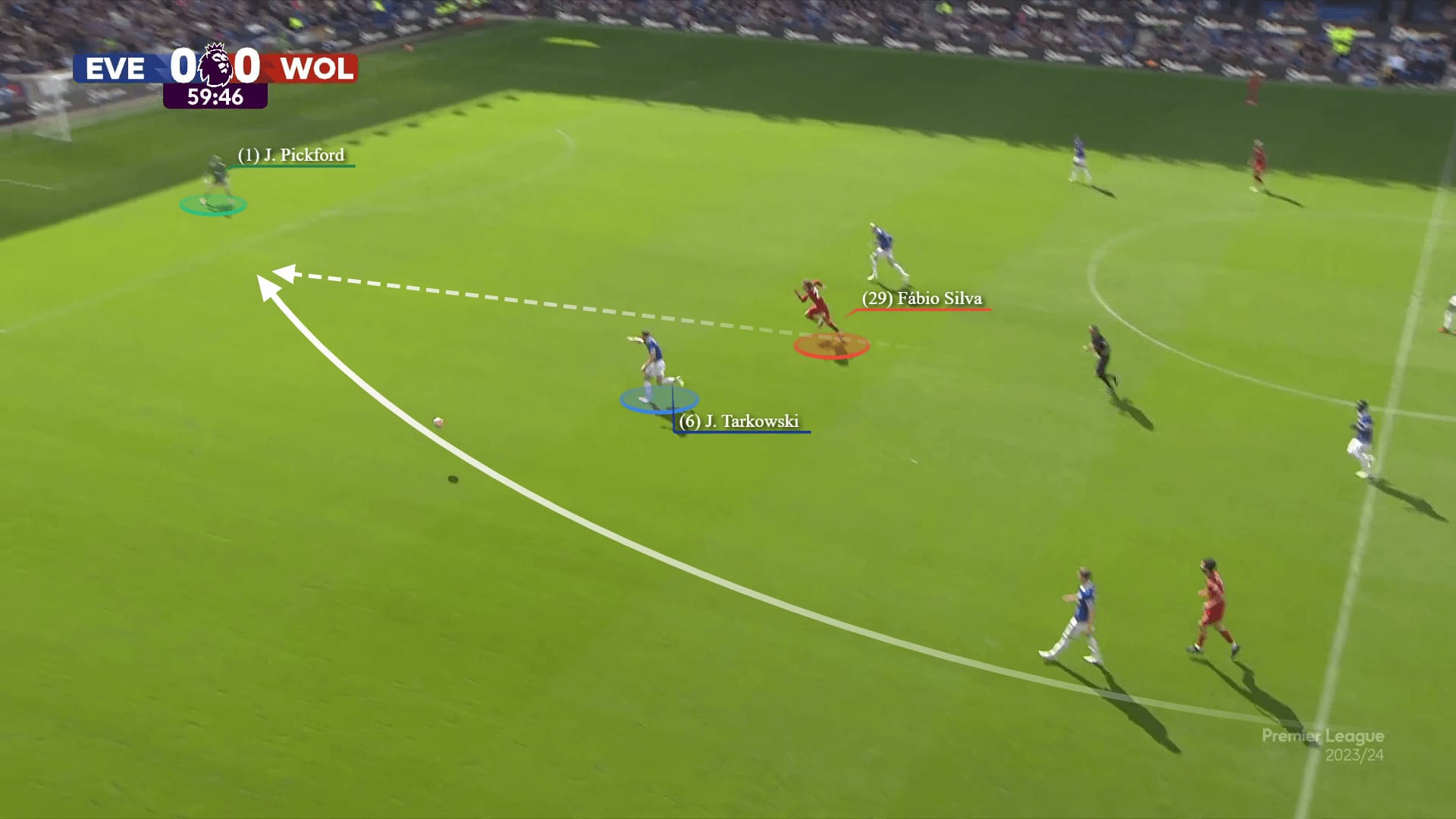
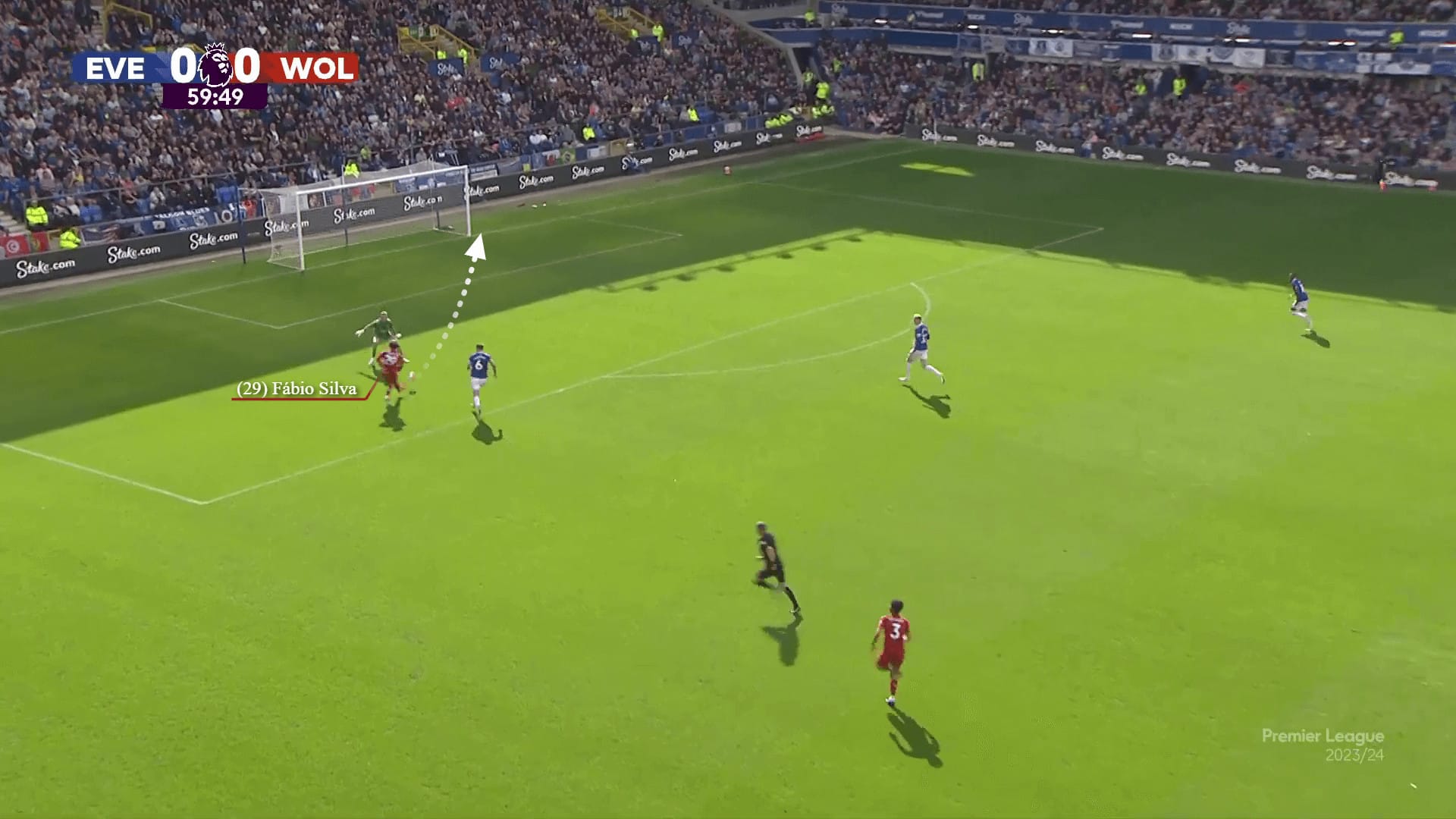
Conclusion
In conclusion, this tactical analysis, in the form of a scout report, provides a detailed overview of the defensive vulnerabilities and tactical issues faced by Everton under Sean Dyche’s management during the 2023/24 season.
These issues include problems with defensive transitions, individual errors, susceptibility to crosses, and difficulties in handling rapid switches of play.
Additionally, the pressing scheme employed by Dyche has shown promise but can be exploited by precise long passes.





Comments